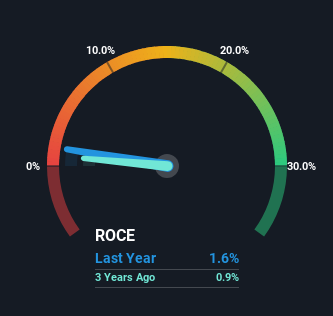- United States
- /
- Interactive Media and Services
- /
- NasdaqGS:BMBL
Bumble's (NASDAQ:BMBL) Returns On Capital Are Heading Higher
If we want to find a stock that could multiply over the long term, what are the underlying trends we should look for? Typically, we'll want to notice a trend of growing return on capital employed (ROCE) and alongside that, an expanding base of capital employed. This shows us that it's a compounding machine, able to continually reinvest its earnings back into the business and generate higher returns. So when we looked at Bumble (NASDAQ:BMBL) and its trend of ROCE, we really liked what we saw.
What Is Return On Capital Employed (ROCE)?
Just to clarify if you're unsure, ROCE is a metric for evaluating how much pre-tax income (in percentage terms) a company earns on the capital invested in its business. To calculate this metric for Bumble, this is the formula:
Return on Capital Employed = Earnings Before Interest and Tax (EBIT) ÷ (Total Assets - Current Liabilities)
0.016 = US$53m ÷ (US$3.6b - US$245m) (Based on the trailing twelve months to December 2023).
Therefore, Bumble has an ROCE of 1.6%. In absolute terms, that's a low return and it also under-performs the Interactive Media and Services industry average of 7.5%.
See our latest analysis for Bumble

Above you can see how the current ROCE for Bumble compares to its prior returns on capital, but there's only so much you can tell from the past. If you're interested, you can view the analysts predictions in our free analyst report for Bumble .
What Does the ROCE Trend For Bumble Tell Us?
Bumble has recently broken into profitability so their prior investments seem to be paying off. About five years ago the company was generating losses but things have turned around because it's now earning 1.6% on its capital. In addition to that, Bumble is employing 8,583% more capital than previously which is expected of a company that's trying to break into profitability. This can indicate that there's plenty of opportunities to invest capital internally and at ever higher rates, both common traits of a multi-bagger.
In another part of our analysis, we noticed that the company's ratio of current liabilities to total assets decreased to 6.8%, which broadly means the business is relying less on its suppliers or short-term creditors to fund its operations. So this improvement in ROCE has come from the business' underlying economics, which is great to see.
In Conclusion...
In summary, it's great to see that Bumble has managed to break into profitability and is continuing to reinvest in its business. And since the stock has dived 82% over the last three years, there may be other factors affecting the company's prospects. Still, it's worth doing some further research to see if the trends will continue into the future.
While Bumble looks impressive, no company is worth an infinite price. The intrinsic value infographic for BMBL helps visualize whether it is currently trading for a fair price.
While Bumble may not currently earn the highest returns, we've compiled a list of companies that currently earn more than 25% return on equity. Check out this free list here.
Valuation is complex, but we're here to simplify it.
Discover if Bumble might be undervalued or overvalued with our detailed analysis, featuring fair value estimates, potential risks, dividends, insider trades, and its financial condition.
Access Free AnalysisHave feedback on this article? Concerned about the content? Get in touch with us directly. Alternatively, email editorial-team (at) simplywallst.com.
This article by Simply Wall St is general in nature. We provide commentary based on historical data and analyst forecasts only using an unbiased methodology and our articles are not intended to be financial advice. It does not constitute a recommendation to buy or sell any stock, and does not take account of your objectives, or your financial situation. We aim to bring you long-term focused analysis driven by fundamental data. Note that our analysis may not factor in the latest price-sensitive company announcements or qualitative material. Simply Wall St has no position in any stocks mentioned.
About NasdaqGS:BMBL
Bumble
Provides online dating and social networking applications in North America, Europe, internationally.
Very undervalued with adequate balance sheet.
Similar Companies
Market Insights
Community Narratives



